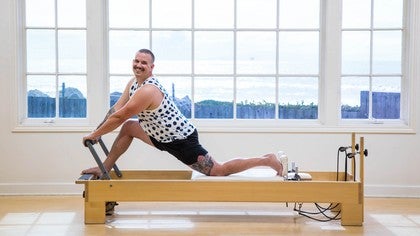Description
About This Video
Transcript
Read Full Transcript
Hey everybody. I'm James crater and I want to welcome you to a somatic meditation today on PyLadies. Anytime. Uh, this is the first part of a three part series. We're doing a meditation to sort of, uh, allow the body to emerge and become, it's a coming to know yourself, meditation, somatic meditation. We'll talk about that. Um, additionally, we're going to do today a, uh, a reformer workout and then a mat class and those will be released independently. But I just wanted you to know that this is the first part of a really cool three part series on humanness. So the first is this meditation and it's a somatic meditation.
Often when we think or hear meditation, we're thinking brain meditations and that's certainly one type of meditation, but this is a different type. This is somatic meditation and a coming to know and coming to feel your body. The, uh, technical term is interoception or the way that my body feels inside of me. And today's meditation is inspired by some work I've done with Bonnie Bainbridge Cohen on primal streaks and, uh, sort of referencing it to some biomechanical stuff. Um, and just some really cool sensations that come from that. So we're going to start off with, uh, the sitz bones and let that sensation travel up through the body.
Biomechanically, uh, why this is beneficial is when the sitz bones get really narrow, it tends to block our hip joints. And, uh, what this is encouraging is a whip through the hip joints and better leg movement. What it really is, is encouraging what is embryologically called the primitive streak. So all of us, if you're here, went through a process of embryology. And so, uh, you have in layman's terms, you have one plate and another plate that come together and about day 15, this really cool thing happens unsupervised unprovoked unperturbed where the bottom of those plates sort of begins to rise up. And that's called the primitive streak. And the primitive streak is what creates your notochord, which is your spinal cord and your organs and that becomes your heart and your limbs. And so this is just honoring that. And, uh, sometimes for me it's helpful to know why things are important to teachers, to know why it might be important to me.
And I want to preface this with everything I say today is not necessarily fact or truth. This is my experience with it. And I think sometimes when we share our experience, it helps our students to incur or encourages our students to explore their own experience with stuff. So having said that, let's get started. What you need is a firm surface today. We're using this uh, hi mat at home. Use a chair, something hard, something from couches. Don't really work for this. Uh, cushy chairs don't really work for this. A bench, a dining chair works really well at the studio.
What I use is a reformer. I just have people put their feet on the ground, which is important and sit on some sort of semi from surface. So the feet on the ground is important because we want to feel grounded, we want to feel connected and that will become more important through the rest of the classes, the reformer class and the mat class. For this, it's important that you feel firmness underneath your sit bones. So we're sitting here and just kind of wiggle around at home and just kind of get a feel of where your sitz bones are. If you don't know what your sits bones are, when you sit on a firm surface, it's the two bones, the right and the left bone. Sometimes if we're seated back, that's us sitting on our tailbone. And if you're seated too far forward, it's sort of uh, onto your hamstrings possibly or too much onto the pubic bone. But if you sort of play around and just kind of adjust things, sometimes if you've got some extra glute muscle or whatever, you just got to pick it up and move it around. And that works too.
So accessing your sits bones primary to this. After that, what I encourage you to do is sort of squeeze your sits bones together, are you doing it? And then from there allow it to get wide. And that's an important distinction. The active process here is the bringing together of the sitz bones and then there is an allowance of the sitz bones to get wide. You can't actually make your sitz bones wide if you're making your sitz bones wide.
Often what you're doing is arching your low back and pushing yourself forward into your pubic bone. That's not really what we're looking for here. We're looking for the distinction between actively bringing your sitz bones together, which is a pelvic floor and sometimes even a gluteal contraction and an allowing of that to open up. And I'm really interested in the allowing thing to happen, cause again, we're working from that primitive streak. We can't make the primitive streak work. And we're actually here inviting an emergence of interoception and emergence of somatic inquiry.
Really fancy words for an emergence of what is this thing that I'm feeling and can I just act back off the activity for a moment and experience something. And that's going to be a through line through the rest of the classes. So I'm sitting here and I'm just allowing my sits bones to be wide. My experience with that is there's a softening inside of my hip joints. There is an opening up that goes on with that.
So play around with that, of bringing your sitz bones together, allowing them to open up wide. Then just sort of notice, well, if I get a little extra weight over onto my right sit bone or my left sit bone, how does that affect stuff? My experience with it is if I'm to weight shifted over to the right, my right sit bone wants to pull towards midline or it wants to tighten in, same as true over on the left. So this is also an encouragement for a midline awareness where I'm just allowing those sitz bones to open up. Now additionally, let's focus up here. Thinking of bringing maybe your, uh, your eyebrows together, kind of squeezing them together and then just allowing them to be open. Uh, I like to do this with my eyes closed. So I'm going to take a moment and go inside of myself while I teach you. Uh, so I'm going to close my eyes and I'm just going to bring my eyebrows together and then I'm going to allow them to open up.
I'm just echoing the process that was down in the sitz bones of allowing things to be wide and actively bringing them together. After you've created an awareness of what it feels like to create tension up in the face, then go, well, what is it like if I allow that tension recognition and the expansiveness distinction to take place behind my eyebrows. What we're really looking for here is sort of pituitary area. So if I was to go all the way through here and the inside of my head, that's the area we're accessing that's unimportant for you to know, uh, uh, physiologically exactly where that is. Just know that it's kind of behind your eyebrows inside of your brain somewhere.
So I can access the sensation by just kind of squeezing together and then allowing wide so I can go down and go sits bones narrow actively or in allowing here eyebrows narrow or an allowing there. From there, see if you can just allow the sitz bones to get wide, the eyebrow space and the space behind it to get wide. And then there's a space in between and that's what we're really interested in there. The space in between is the spinal channel or embryologically what's known as the notochord, which becomes all of the nervous system, the Vegas nerve, um, internal organs. And that's the area that even, uh, Joseph [inaudible] was very interested in with spinal fluidity and spinal movement. So it doesn't really matter what your interest is. Just know that this meditation is good for probably accessing whatever you're interested in, whether it's an empathetic, compassionate heart, whether it's co-regulation through the Vegas nerve, whether it is spinal movement and biomechanical processing that way.
So I have the space on the bottom and I'm allowing that to be wide and have the space on the top and I'm allowing that to be wide in between. I'm just going to concentrate and feel the connection between the two. What's really interesting to me is as I process this, I tend to get kind of tight up through the thoracic spine and I have a really, uh, palpable sense of, of how the sitz bone feeling rises up through the body. But when I get right about pretty much where it, where this says all good, never better. It's really hard for me to sense in my own body. That imaginary line, yours might be different if you have some low back congestion.
If there's something up in your neck that routinely bothers you, maybe that's where, uh, this imaginary sensation is a little harder to tap into and that's important information. It's important information because as we begin to move where we can't connect to brain-wise is often where we can't move well in real life. So just spend a moment and go, Oh, that's really interesting. That's where it gets stuck and that's where I kind of get stuck sometimes. So rather than forcing it in movement, maybe I can begin to access it through a meditation.
So I'm just going to be here allowing that sensation to travel up sitz bones wide, Headspace wide, the space in between sort of fluid and aware is a good word. From there I recognize that I have space to my right and I have space to my left. I have this imaginary line midline that's happening and the space to the right can be recognized in any number of ways. The space to the right can be recognized from the midline over to my ribs are over to my side abs, so be with that for a moment. Can I sit and have that imaginary midline?
Just be aware of the space inside of my body to the right. Then from there, can the space to the right be recognized or can I sense where I am in space all the way to the wall? To your right? That's a little harder. Can I recognize how long the table is here? What is in the room over there? How much space is it? 20 feet? Is it 10 feet? Is it 50 feet? From there, can I begin to sense space beyond the wall?
Meaning how far to the right here we're in Santa Barbara, so can I to the South. Here we have Carpentaria. We have Ventura. We can make our way all the way down to LA, down to Mexico. How far can my brain begin to go? Well, how much South can I comprehend in this moment or how much to the right here can I comprehend in the moment? Then you can just be there for a bit. Sitz bones wide, Headspace, wide space to the right for me, right side is easy, left side is hard. So I began to concentrate over onto the left side and even in my own body, my own experience is that I don't, I don't comprehend left ribs very well.
So I'm here and I'm just going, well, can I become aware of what's over there and I'm just going to hang out for a bit because I need this meditation as much as you do. And then can I also begin to sense what's over here to the left. My experience with this, and yours is probably different, but maybe it can be informed by mine, is when I start to process what's going on, the left get kind of tingly, not in a palpable like fizzy sensation. It's just uh, um, sparks of intrigue in my brain. Go like, Oh, what is over to the left? What is over there where the right's like, got it. I understand. I know exactly where that is.
So I'm going to spend some time paying attention to the leftover here and just how far can I go to the wall? Can I go to the next town up? Can I go to the next state up? What's over there? To the left, as I have explored this and my students have explored this, we found this really, really valuable, especially as we begin to go into lateral work. We don't move laterally, you know, unless you're a football player, like you've never even processed how to move laterally. Really. Uh, and, and so there's a lot of issues with that.
Think about your sideline leg series and how you have that one good side and that one not so good side. Well, it's usually the side that you can't meditate towards. And so what this is allowing this meditation is allowing for the sitz bones to be open, the spinal channel to be open. And you are in the state of receiving in the state of curiosity. And what we're doing here is allowing our awareness to just shift to the left. And what I find is that especially as you begin to move, if you are just interested in what's going to the left, your body just or sort of moves to the left or moves to the right.
So as we begin to play with movement and the rest of the classes begin to think about this stuff, can I allow my sitz bones to be wide, my Headspace to be wide and the space in between the BYD, which is an act of allowing, it's an act of curiosity. It's an act of embryologic emergence where I'm not making something happen, I'm allowing it to happen and it puts me in a space of going, huh, isn't that interesting? I'm really very interested in data collection of resourcing what is being, I'm very interested in the scientific method through movement more so than I am interested in efforting, making something happen, uh, copying something. So this meditation is permission for you to open up, relax, get curious and heighten your awareness through interoception. And I hope you find it valuable. If you have [inaudible] joint issues, this is really going to help if you have anxiety issues.
This is actually a really interesting piece of information. Uh, the Vegas nerve, which is our gut instinct nerve kind of travels up through the heart and into the brain. Uh, it's the whole gut instinct thing. Well, it interdigitates or communicates with what is called your pudendal nerve plexus. That's your pelvic floor, nerve plexus. And what's interesting about that is it's what allows us to register safety and security down in the pelvis. Like is everything working well down there? When we bring the sitz bones together, it's actually, uh, which is a pelvic floor contraction, which is an over gluteal squeeze, which is sitting constant. This position, it's this position. When you do that chronically, it stimulates in a, in a not so advantageous way, the pudendal nerves, which causes you to be more anxious all the time. So this is just an opening up and allowing and a presence meditation through the sits bones. The really nice thing is you can do this anywhere.
You can do this at dinner, you can do this in your car, you can do this while you're walking, but she got to know what it feels like first. So you got to start here. It's also a resource that we'll reference later on through the work. Can I allow my sits bones to be wide and if not, why can't I not? What's going on that I can't access that? Can I become aware to the space, to the right and to the left? If not, why can I not? What's going on with that? What's going on with the spinal channel all the way up?
Can I become more aware of myself all the way up or can I not? What's going on with that? So the more you practice this, the more access you'll have and the more you'll understand the rest of the two classes. It's really good. Biomechanically, it's really good. Somatically. I love it. And at all my workshops I tell people if I can have a legacy here on earth, it sits bones wide. So help me out, help me create my legacy of sits bones wide and hopefully it helps you too. And stay tuned.
We have a really great reformer class come in for you and a really exciting mat class that I hope you enjoy. Thank you so much. I appreciate your time.
Mindful Movement: Centering Exploration
Comments
You need to be a subscriber to post a comment.
Please Log In or Create an Account to start your free trial.





























